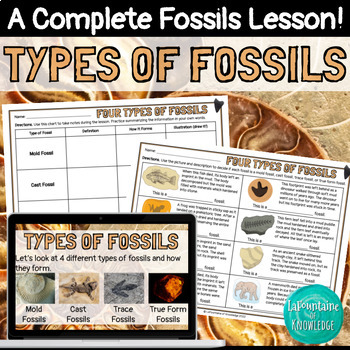Types of Fossils Lesson with Google Slides, Notes, Worksheet, and Answer Key
- PDF
- Google Apps™

What educators are saying
Also included in
- This fossils unit bundle includes 8 one hour lesson plans with all of the resources needed to implement them in your science classroom. The unit explains what fossils are and how they form, 4 different types of fossils (mold, cast, trace, and true form), the law of superposition (relative dating), aPrice $17.32Original Price $24.75Save $7.43
Description
This lesson explains what a fossil is and explores 4 different types of fossils - mold, cast, trace, and true form - including how they form with examples of each.
This resource includes:
- a Google Slides lesson about the 4 types of fossils
- a notes page (print and digital, color and black line)
- a worksheet (print an digital, color and black line)
- an answer key
Go through the Google Slides presentation as students take notes on the included notes page. After the lesson, students use their notes to complete the worksheet. The worksheet describes a fossil (with an illustration). Students read the description and use their notes to decide which of the 4 types of fossils it is. An answer key is also included.
If you prefer to assign this lesson virtually, digital versions of the notes and worksheet are included at the end of the Google Slides lesson.
Please follow my store here for more great resources!
You can also find me on Facebook, Instagram, and lafountaineofknowledge.com where you'll discover ideas, inspiration, and plenty of freebies! Or join my email list to get my monthly newsletter with exclusive FREE resources you can't get anywhere else!
Want free money to spend on Teachers Pay Teachers? Rate this product to earn some TpT credit! Leaving feedback helps us both out and takes less than a minute! Your support makes it possible for me to continue making and sharing great resources! Thank you!






